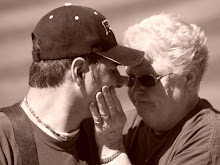As defined by HowStuffWorks.com:
Stem cells are unprogrammed cells in the human body that can be described as "shape shifters." These cells have the ability to change into other types of cells. Stem cells are at the center of a new field of science called regenerative medicine. Because stem cells can become bone, muscle, cartilage and other specialized types of cells, they have the potential to treat many diseases, including Parkinson's, Alzheimer's, diabetes and cancer. Eventually, they may also be used to regenerate organs, reducing the need for organ transplants and related surgeries.
"Stem cells are like little kids who, when they grow up, can enter a variety of professions," Dr. Marc Hedrick of the UCLA School of Medicine says. "A child might become a fireman, a doctor or a plumber, depending on the influences in their life -- or environment. In the same way, these stem cells can become many tissues by making certain changes in their environment."
Stem cells can typically be broken into four types:
· Embryonic stem cells - Stem cells taken from human embryos
· Fetal stem cells- Stem cells taken from fetal tissue
· Umbilical stem cells - Stem cells take from umbilical cords
· Adult stem cells - Stem cells taken from adult tissue
Embryonic and fetal stem cells have the potential to morph into a greater variety of cells than adult stem cells do. They were first isolated in the lab in 1998.
Prior to being transplanted into a person's tissue to begin regeneration of that tissue, stem cells have to go through differentiation. Differentiation is the process by which scientists pre-specialize the stem cells, almost like preprogramming the stem cells to become specific cells. These cells are then injected into the area of the body being targeted for tissue regeneration. When stem cells come into contact with growth chemicals in the body, the chemicals program the stem cells to grow into the tissue surrounding it.
Why for ALS?
People who have ALS steadily lose their ability to control muscle movement. Patients in the later stages become totally paralyzed, although their minds are often unaffected. The average life expectancy of a person with ALS is only two to five years from time of diagnosis. Many ALS sufferers die from failure of the nerve cells that control breathing. The cause of ALS is unknown and there is currently no cure. One FDA-approved drug, Rilutek, helps slow the progression of ALS. Still, no existing treatment is known to halt or reverse the disease.Potential for Stem Cell Therapies and CuresRecent studies indicate that stem cells can generate healthy new nerve cells. This could potentially provide a way to replace those that are lost as a result of ALS. One possible approach is to develop new motor neurons from human stem cells and then introduce them into regions of the body where motor neurons have died. In other recent studies, researchers have used stem cells to develop astrocytes, special cells that nourish and support brain and spinal nerve cells. These cells could, in turn, help regenerate nerve cells and reduce symptoms associated with ALS.Stem cells can also be engineered to deliver “trophic factors” and other chemicals that protect vulnerable nerve cells or even restore function to those already damaged.
Information obtained from the California Research and Cures Act.
Tuesday, February 5, 2008
Subscribe to:
Post Comments (Atom)
Family is FOREVER








No comments:
Post a Comment